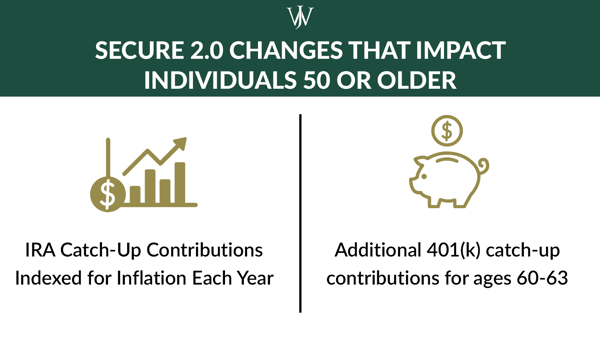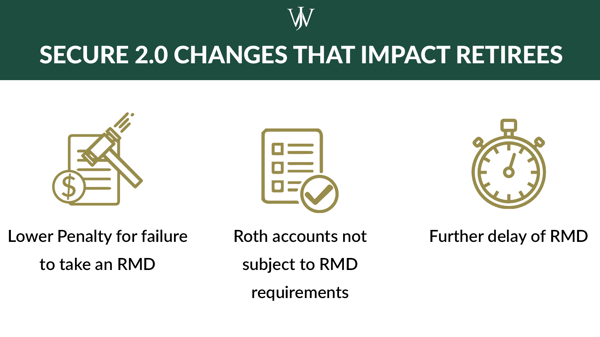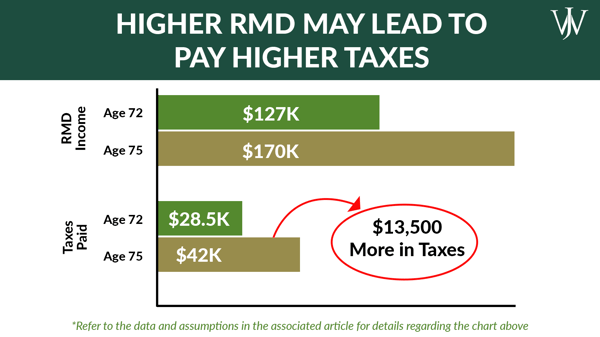With recent volatility in the market, we are all concerned about our retirement assets. And while we should regularly put pencil to paper to see if our retirement assets will outlast our life expectancy, a nagging question overhangs it all, “Should I have saved more?” And the truth is: Yes, most of us should have saved (and should be saving) more for retirement unless we have sufficient wealth that spans several generations.
Don’t despair -- here is some good news! We now have added opportunities to save more for retirement, especially for individuals aged 50 and older. These opportunities come from the recently passed Consolidated Appropriations Act 2023, which includes the provisions of SECURE 2.0. We want to highlight the provisions of this recently passed legislation that are designed specifically for employees to increase their retirement savings.
What is the Consolidated Appropriations Act & SECURE 2.0?
The retirement provisions of the Consolidated Appropriations Act encompass the year-long negotiations of Congress intended to expand the original SECURE Act, enacted in December 2019.
There is a great need to address the abysmal statistics on financial readiness for American retirees. Americans are working longer because Americans are living longer—outliving their financial resources. Plus, Americans like their lifestyle and will withdraw cash early from their retirement savings to buy boats, cars, or finance that trip to Europe. While there are no significant immediate consequences for these actions, such withdrawals really do cause problems down the road when the boat and car are long gone.
And in recent months, the high inflation rate is taking a toll on existing retirement savings. So, these additional savings opportunities bring good news to individuals concerned about their retirement years. The provisions included in the Consolidated Appropriations Act are vast, spanning over 2,000 pages. There are several provisions for the self-employed, for those with terminal illnesses needing to make early 401(K) withdrawals, and more. However, for the purpose of this article, we’re focusing on the provisions related to employees and retirees aged 50 or older. So, let’s dive into the provisions high-earning employees can employ today to put more cash in their pockets for their future retirement.
What Does SECURE 2.0 Mean if You’re 50 or Older?
For several years now, employees aged 50 or older have been able to make additional contributions to their 401(k)s and IRAs. These are known as “catch-up contributions” and are based on the notion that individuals who are 50 years and older can put more money away as they near retirement to cover their retirement needs. If taken advantage of from the age of 50, these catch-up contributions can yield a significant source of additional retirement savings.
Changes to Retirement Account Contribution Limits from SECURE 2.0
 Here is a list of the new changes to catch-up contributions:
Here is a list of the new changes to catch-up contributions:
1. Inflation indexing of IRA catch-up contributions. Before SECURE 2.0, the historic catch-up contribution limit for an IRA has been $1,000 each year. Given the new provisions, the IRS can index these catch-up limits against inflation and make annual adjustments for the IRA catch-up contribution starting January 1, 2024.
2. Additional 401(K) catch-up contributions to employee plans for ages 60 through 63: Beginning in 2025, individuals aged 60-63 participating in an employee 401(K) plan or a similar plan will be able to make additional catch-up contributions. This catch-up will increase to a maximum of $10,000 per year for 401(k)s (subject to limitations) and will be indexed yearly for inflation.
Beginning January 1, 2024, if your compensation exceeds $145,000 (subject to inflation), the new law requires all catch-up contributions to qualified plans to be Roth contributions.
For those whose compensation is $145,000 or less, catch-up contributions can be made on a pre-tax basis.
SECURE 2.0 Changes for Retirees or Individuals Over Age 72
In addition to the abovementioned changes, the following changes will also affect those aged 72 and older.
 1. Lower Penalty for failure to take an RMD: We often encourage our clients to take RMDs when required to avoid losing any of their retirement savings to penalties. Penalties are never a good way to spend hard-earned or hard-saved cash, but in the event that you do forget to take your RMD, the penalty is reduced from 50% to 25%. If you make the corrective distribution in a timely manner, you will receive an additional reduction in the penalty down to 10%.
1. Lower Penalty for failure to take an RMD: We often encourage our clients to take RMDs when required to avoid losing any of their retirement savings to penalties. Penalties are never a good way to spend hard-earned or hard-saved cash, but in the event that you do forget to take your RMD, the penalty is reduced from 50% to 25%. If you make the corrective distribution in a timely manner, you will receive an additional reduction in the penalty down to 10%.
As penalties are always punitive by their nature, our key takeaway here may not provide much comfort. The best and easiest way to protect retirement savings is just to take the RMD and skip the penalty.
2. Roth accounts in your employer retirement plan are no longer subject to RMD requirements: Beginning January 1, 2024, if you have a Roth account held in your employer retirement plan, you will not be required to take RMDs at all. This is a wonderful incentive to switch your retirement plan contribution to a Roth account, facilitating very long-term growth inside the Roth retirement account.
3. Further delay of Required Minimum Distributions: At age 72, individuals have been required to begin taking withdrawals from their IRAs (or 401ks). These withdrawals are termed “required minimum distributions” or RMDs.
Under the new SECURE 2.0 provisions, an individual can delay taking RMDs beyond the age of 72. Here is a chart showing the delayed RMD provision based on age:
| Date Range | Age to begin RMDs |
| From January 1, 2023 – December 31, 2032 | Age 73 |
| From January 1, 2033 – Beyond | Age 75 |
Should You Take an RMD at 72 or 75?
Now, we do want to provide you with some food for thought here. You may be able to delay your RMD to 75, but should you? If the delay in RMDs causes you to take a larger RMD at 75 that pushes you into a higher tax bracket, is it worth it? You will definitely want to crunch the numbers here before you choose to delay that RMD to 75.
Let’s consider an example.
Today, you are 72 years old and have an IRA that is worth $3,500,000. Under the former RMD distribution rules, you would be required to begin taking an RMD at the age of 72 in the amount of approximately $127,700 each year. Assuming you are single, receive $30,000 in taxable Social Security benefits, and take the standard deduction, your tax rate will be in the 24% tax bracket. The tax on this scenario is approximately $28,500.
Now, let’s say you decide to delay your RMD to age 75, and your IRA increases in worth to $4,168,556 (assuming a growth rate of 6% per year). Your RMD at age 75 will be close to $170,000. If we assume your taxable Social Security benefits at 75 are now $35,000, then the tax on this scenario is almost $42,000, which is significantly higher than $28,500.

Here is a list of considerations when deciding what age to take that RMD:
- What is the approximate lifetime tax liability if you begin taking your RMD at age 72 versus age 75?
- What are current and expected market conditions? Is it a bear market and the value of your IRA is continuing to decline? Or is the market climbing?
- What are your cash flow considerations at 72 versus 75?
- What other income sources do you have?
You will likely need a financial advisor to assist you with the number crunching to ensure that all these points are considered in this very important decision. The decision to begin taking your RMDs at age 72 versus 75 is significant, and you don’t want to risk leaving money on the table by choosing a less optimal age to take your RMD.
Preparing for Retirement with Fiduciary Financial Advisors
At Willis Johnson & Associates, we believe that optimizing your retirement savings and mitigating your taxes is an important piece of your financial plan and is essential to helping you achieve your financial goals. Our advisors are experts in your company benefits and can provide a complimentary first meeting to determine whether you are taking full advantage of your company benefits. Our advisors also are skilled at number-crunching on all the aspects of critical decisions, like when to begin taking RMDs. Learn more about our services and our commitment to helping your family make the most of your resources at every stage of life.







